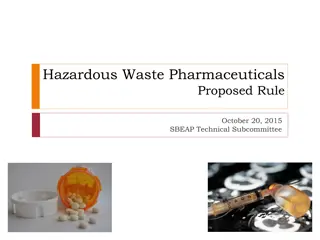Sustainable Practices for Reducing Consumable Waste
Consumable waste poses environmental challenges for consumers, impacting them both positively and negatively. This overview discusses food waste, the impact of packaging materials, and suggestions for reducing waste creation. Understanding where packaging waste ends up and how food waste can be composted are essential components of a sustainable lifestyle.
Download Presentation

Please find below an Image/Link to download the presentation.
The content on the website is provided AS IS for your information and personal use only. It may not be sold, licensed, or shared on other websites without obtaining consent from the author. Download presentation by click this link. If you encounter any issues during the download, it is possible that the publisher has removed the file from their server.
E N D
Presentation Transcript
Consumable waste By: Emelia Sinnott
Food waste A good majority of the food I eat does come in many different packaging but me and my family do try to get most produce and other products without many bags so that we can reduce our plastic waste. A lot of the packaging that we do get with our produce is usually plastic , cardboard, glass and a small amount of Styrofoam All these materials that are used for the products are specifically chosen because of if they are a poultry item, fruit, vegetable item or something that doesn t have to be refrigerated which would come in either glass or a tin can. For example poultry would come in Styrofoam because the Styrofoam doesn t absorb any of the juices that may come out of the item.
How packaging is negatively and positively impacting consumers Packaging is negative for the consumer because they have to worry about where it goes after they are done with it. It is also negative because it can collect up in their house and clutter up. On the other hand it can be positive for the consumer because it can help keep their food sealed, and not contaminated.
What happens to packaging materials when we are done with them When we are finished using packaging materials once the product we are using is done, it will be hopefully thrown away in the right spots and picked up or dropped off to recycling sights where they will then sort through it all and try and salvage as much to recycle. Although a lot of people do that some people don t and they will just put everything in the garbage which intern will go to the land fill and sit there for forever.
Where is the packaging waste after one day? One year? One hundred years? Once packaging is used after one day it will mostly stay in the location it was put it in, either the garbage, recycling, cans etc.. But after a year it will be created into new stuff or in a landfill. After one hundred years, plastic will have been turned into more plastic and the garbage will still be right where it was left in the landfill, but if it was littered could have traveled the world.
What happens to the food waste? Food waste is composted, it will compost/break down and either be used to grow more food or be turned into materials made from composted materials.
Provide 3-4 suggestions for ways that consumers can decrease the amount of waste we create. 1. one way that consumers can decrease the amount of waste created is to buy less products that come in packaging that can t be recycled 2. Another way is to bring your own mesh produce bags to the grocery store so that you don t have to use plastic bags. 3. The third way to reduce on waste is to reuse containers. For example glass jars, parchment paper plastic ziplock bags etc..























